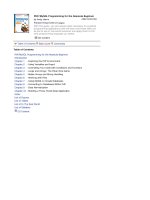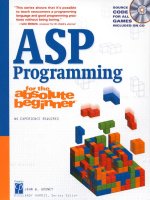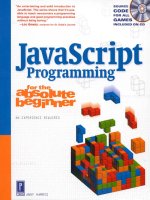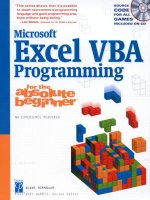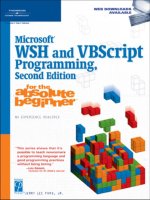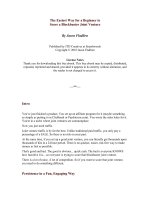Manga for the beginner shoujo christopher hart
Bạn đang xem bản rút gọn của tài liệu. Xem và tải ngay bản đầy đủ của tài liệu tại đây (32.32 MB, 320 trang )
Contributing Artists:
Christopher Hart
Rhea Silvan
Tabby Kink
Roberta Pares
Laichro
Adetyar Rakhman
Tina Francisco
Erica Awano
Front cover design by and interior design adapted by woolypear
Copyright © 2010 by Cartoon Craft, L.L.C.
All rights reserved.
Published in the United States by Watson-Guptill Publications an imprint of the Crown Publishing Group a division of
Random House, Inc., New ork
www.crownpublishing.com
www.watsonguptill.com
WATSON-GUPTILL is a registered trademark and the WG and Horse designs are trademarks of Random House, Inc.
Library of Congress Cataloging-in-Publication Data
Hart, Christopher.
Manga for the beginner shoujo : everything you need to start drawing the most popular style of Japanese comics /
Christopher Hart. — 1st ed.
p. cm.
Includes index.
eISBN: 978-0-8230-0838-4
1. Comic books, strips, etc.—Japan—Technique. 2. Cartooning—Technique.
3. Comic strip characters. I. Title.
NC1764.5.J3H369285 2010
741.5’1—dc22
2009050997
v3.1
If you can dream it, you can be it.
CHRISTOPHER HART
Contents
Introduction
The Shoujo Face
Manga Styles
Regular Eyes vs. Shoujo Eyes
The Face: Front View
The Face: Pro le
The Face: 3/4 View
Expressions
Female Hair Dynamics
Girls with Hats
Teen Boy Hairstyles
Female Bodies & Motion
Female Body Types
Simpli ed Female Body
Silhouettes
Drawing Poses with Movement
Expressive Poses
The Shoujo Girls
Cat-Girls
Magical Girl
Tennis Player
J-Rocker
“Fantasy” Occupations
Fairy
Princess Fighter
Sci-Fi Fighter
On the Edge: “Evil” Girls
The Shoujo Boys
Young Teen Boys
Older Teen Boys
The Super-Elegant Guys
The Key to Successful Drawing
Standing
Walking
Sitting
Kneeling
Putting It All Together
Character Interaction
Pinups
Index
HERE’S A SPECIAL BOOK for those interested in drawing the
shoujo (pronounced show-joe) style of manga. Shoujo is the
style of manga that’s aimed at teenage girls but that also has
garnered a strong male following. Also spelled shojo, it’s the
most popular style of manga in the known universe—and this is
the rst book speci cally designed to teach beginners how to
draw it. Maybe you’ve had some experience with other forms of
art but your manga needs a little help. Or maybe you’ve been
sort of faking your manga and want to kick it up to the next
level. Either way, this book is designed for you.
Manga for the Beginner Shoujo adds additional steps to the
normal step-by-step format to make sure you can follow the
tutorials at every point along the way. It also features a
comprehensive amount of art principles to lay a foundation for
your manga as you continue through this book and beyond.
Your favorite characters are included, from magical girls to
handsome teen boys to cat-girls, Goth boys, demon gals, and
more. You’ll also learn the secrets of how to draw the wildly
popular elegant, older-male teenage shoujo character. This
famous manga
gure from Japan is experiencing an
unprecedented wave of popularity in graphic novels in America
today, and he’s featured here in an in-depth chapter complete
with lots of step-by-step breakdowns and special drawing hints.
In other words, you’ll be learning the basics on the most
outrageously cool characters in shoujo. No boring mannequins
for you to copy here. This is the real deal: authentic manga,
drawn in the latest style Tokyo has to o er. Why settle for
anything less?
The text is also particularly helpful to beginning artists, as it
explains the lessons in a breezy manner. Extra tips and insights
are o ered on everything from coloring to character
development. This book has got your back every step of the
way. You may start o as an otaku (a manga fan), but you’ll
end up a mangaka (a manga artist)!
THE SHOUJO LOOK REQUIRES special elements and
proportions: big, glistening eyes; a small mouth; and a tiny
nose. Often, I see beginners taking great care to draw elaborate
eyes. They intuitively understand what a big role this feature
plays in a character’s design. But what they don’t always
realize is that for a character to have big eyes, it also has to
have a huge forehead. To counterbalance this, the character
has a small mouth area. This is the very de nition of the “cute”
head type and is one of the reasons they shoujo head is so
appealing. So remember: No feature exists all by itself. It must
coexist within a framework that accommodates its unique size
and shape.
MANGA STYLES
What is the shoujo style? Shoujo is the most widely read genre of
Japanese comics. It features teen characters and leans more toward
stories aimed at young female readers, though boys read it avidly, as
well. The girls are drawn pretty and cute. The boys have youthful
good looks. Older-male teens are drawn as dashing, mature leading
men. (We’ll cover the various male characters starting on this page.)
We’ll concentrate on the female characters for now, because
they’re the stars of the genre (and also the main audience). Age
range is important: As the age range of the characters changes, the
genre changes. So it’s important to keep your shoujo girls between
ages twelve and seventeen. If you go lower or higher than that, you
start to enter into genres other than shoujo, as you’ll see here.
CHIBI
Ages 5–8
KODOMO
Ages 8–11
SHOUJO
Ages 12–17
BISHOUJO
Ages 18–21
REGULAR EYES VS. SHOUJO EYES
Because shoujo is famous for its glamorous eyes, we’ll spend a little
extra time on this feature.
The rst column shows how a beginner might draw manga eyes.
They’re quite plain and all starkly black and white. The eyes in the
second column are done like a professional manga artist would draw
shoujo eyes: with a lighter touch and “feathered” to give a softer,
glistening look. The lashes, too, are thicker and more profuse. Try
copying some of these. You don’t have to get them perfect the rst
time. It takes a few tries. Don’t be too critical of yourself.
Remember, it’s just the start of the book.
REGULAR
SHOUJO
Glossary of Manga Eyes
There’s no single right way to draw manga eyes. If you don’t like
one style, there are many others from which to choose. Use this
glossary of examples to nd one that suits your taste. You can pick
from what’s here or improvise to make it your own. Notice that it’s
not just the shading that makes the eyes unique but the shape of the
eye itself. Some eyes will feature long lashes, some short, and some
none at all. Some eyelids press down on the eyeball, and some arch
above the eye, leaving a space between eyelid and eyeball. But in
every case, the eye is large and round, with plenty of shines.
THE FACE: FRONT VIEW
We’ll start with the front view, because everything is perfectly
symmetrical at this angle, and everything lines up evenly: two eyes,
two eyebrows, two ears, all at the same level.
Notice that the eyes are left blank in the early steps. That’s
because you rst want to focus on getting all the features in the
right place before adding the details. It’s at this beginning stage that
you do the most erasing and correcting. Don’t be afraid to make
mistakes. That’s how you learn. All professional artists use erasers—
and lots of them!
Girls
When drawing the shoujo girl’s head, remember this axiom: big
forehead, small mouth area. This rule will result in a modi ed egg
shape. It’s easy to draw, and it works. Make sure that the forehead is
big enough to t in those enormous eyes. But also, a big forehead is
the typical look of young adolescent characters. As a character ages,
the eyes move higher up on the head, which makes the forehead
look smaller.
